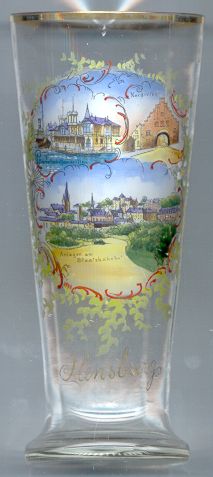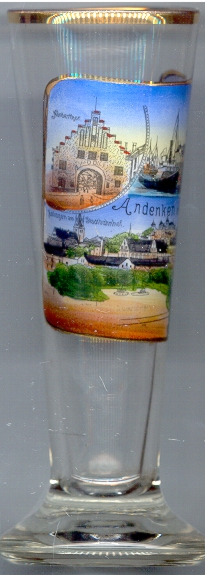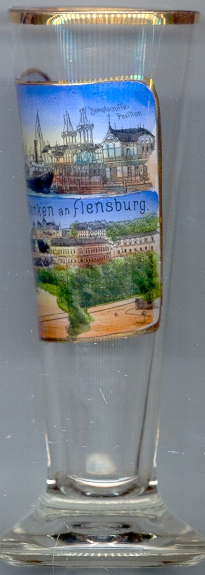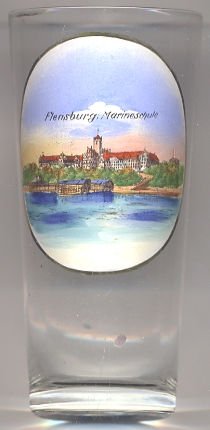

|
| DEUTSCHLAND | GERMANY |
| Bundesland: Schleswig-Holstein | |
| Stadt: Flensburg |
 Flensburg (Danish: Flensborg), Germany's northermost town, is situated at the western end of the Flensburger Förde (Firth of
Flensburg). The first village was founded by Danish fishermen in the 12th century and soon became an important trading
place. In 1284 it was chartered as a town by the Danish King Valdemar IV. When King Christian I became Duke of
Schleswig and Count of Holstein in 1460, Flensburg became part of the Danish kingdom and remaind
so for next four centuries. By the 16th century, Flensburg became the most important Danish trading town for the whole
Baltic region. The Reformation was introduced in the city in 1525. The Thirty Years' War (1618–1648) and the Nordic
War (1700–1721) destroyed Flensburg's wealth for a long time. By the 18th century, however, Flensburg had
recovered its strong position in seafaring, ship-building, trading and crafts. The rum trade with the West Indies earned it
the nick name 'rum city' of that time. During the 19th century, the struggles between Denmark and Germany over the
border region began. The revolt of Schleswig-Holstein against Denmark (1848–1851) eventually led to the
German–Danish War of 1864 (Second Schleswig War). The war ended with the Treaty of Gastein
(Gasteiner Konvention) 1865. Prussia received the duchies of Lauenburg and Schleswig, whereas
Austria was given control over Holstein. In 1867 Holstein also became Prussian and since then formed the Prussian province
of Schleswig-Holstein. After World War I, the population of Flensburg decided in 1920 in a referendum to stay with
Germany, but the northern parts of the region became parts of Denmark. At the end of world War II, Großadmiral
Karl Dönitz, also Reichspräsident since 1 May 1945, and the German government had taken refuge in the naval
station of Mürwik at Flensburg. It was from here that Dönitz declared Germany's unconditional capitulation in a
radio broadcast on 8 May 1945.
Flensburg (Danish: Flensborg), Germany's northermost town, is situated at the western end of the Flensburger Förde (Firth of
Flensburg). The first village was founded by Danish fishermen in the 12th century and soon became an important trading
place. In 1284 it was chartered as a town by the Danish King Valdemar IV. When King Christian I became Duke of
Schleswig and Count of Holstein in 1460, Flensburg became part of the Danish kingdom and remaind
so for next four centuries. By the 16th century, Flensburg became the most important Danish trading town for the whole
Baltic region. The Reformation was introduced in the city in 1525. The Thirty Years' War (1618–1648) and the Nordic
War (1700–1721) destroyed Flensburg's wealth for a long time. By the 18th century, however, Flensburg had
recovered its strong position in seafaring, ship-building, trading and crafts. The rum trade with the West Indies earned it
the nick name 'rum city' of that time. During the 19th century, the struggles between Denmark and Germany over the
border region began. The revolt of Schleswig-Holstein against Denmark (1848–1851) eventually led to the
German–Danish War of 1864 (Second Schleswig War). The war ended with the Treaty of Gastein
(Gasteiner Konvention) 1865. Prussia received the duchies of Lauenburg and Schleswig, whereas
Austria was given control over Holstein. In 1867 Holstein also became Prussian and since then formed the Prussian province
of Schleswig-Holstein. After World War I, the population of Flensburg decided in 1920 in a referendum to stay with
Germany, but the northern parts of the region became parts of Denmark. At the end of world War II, Großadmiral
Karl Dönitz, also Reichspräsident since 1 May 1945, and the German government had taken refuge in the naval
station of Mürwik at Flensburg. It was from here that Dönitz declared Germany's unconditional capitulation in a
radio broadcast on 8 May 1945.

 The
The  Nordertor [left, no. 1310: top left] was built in 1595 and marked
the northern boundary of the city for 200 years. Between 1881 and 1903 several plans to tear down the edifice were dismissed
by the city government. In 1913/1914 the gate was renovated and since then is a beloved landmark of Flensburg.
Nordertor [left, no. 1310: top left] was built in 1595 and marked
the northern boundary of the city for 200 years. Between 1881 and 1903 several plans to tear down the edifice were dismissed
by the city government. In 1913/1914 the gate was renovated and since then is a beloved landmark of Flensburg.
The top right picture on glass no. 1310 shows the historic  Steamship
Steamship
The bottom picture a view of the  Park
Park
 The
The  Naval Academy (Marineschule Mürwik) [left, no.2954]
is the main training establishment for all German Navy officers and replaced the German Imperial Naval Academy in
Kiel. It is located at Mürwik, a city borough of Flensburg. The Naval Academy was established
at this site by the order of Emperor Wilhelm II in 1910. Its unique gothic architecture with the dominating red bricks
was meant to imitate the famous Ordensburg Marienburg (today, Malbork, PL), founded in 1274. When
Adolf Hitler committed suicide in the final days of World War II in 1945, Grand Admiral Karl Dönitz assumed the
office of President (Reichspräsident) of Germany as Hitler had named him his successor before. Dönitz moved from
nearby Glücksburg to the Naval Academy at Mürwik to establish the Flensburg government.
Soon after the final surrender to the Allies, they were unseated and arrested by British troops. This made Flensburg capital
of Germany for nearly 20 days. Today, The Naval Academy at Mürwik carries out both, the basic education of the young
officer cadets as well as parts of the advanced training for officers.
Naval Academy (Marineschule Mürwik) [left, no.2954]
is the main training establishment for all German Navy officers and replaced the German Imperial Naval Academy in
Kiel. It is located at Mürwik, a city borough of Flensburg. The Naval Academy was established
at this site by the order of Emperor Wilhelm II in 1910. Its unique gothic architecture with the dominating red bricks
was meant to imitate the famous Ordensburg Marienburg (today, Malbork, PL), founded in 1274. When
Adolf Hitler committed suicide in the final days of World War II in 1945, Grand Admiral Karl Dönitz assumed the
office of President (Reichspräsident) of Germany as Hitler had named him his successor before. Dönitz moved from
nearby Glücksburg to the Naval Academy at Mürwik to establish the Flensburg government.
Soon after the final surrender to the Allies, they were unseated and arrested by British troops. This made Flensburg capital
of Germany for nearly 20 days. Today, The Naval Academy at Mürwik carries out both, the basic education of the young
officer cadets as well as parts of the advanced training for officers.
[https://en.wikipedia.org/wiki/Naval_Academy_Mürwik]
![[scale]](lineal.jpg)